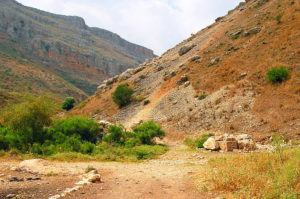
Road to Nazareth, through Israel’s Arbel Pass (Photo by Don Knebel)
For thousands of years, people have created dwellings in the caves on the cliff face of Mount Arbel, the southeastern of the two mountains separated by the Arbel Pass. In about 40 B.C., residents around the Sea of Galilee rebelled against the Roman appointment of Herod as their king. When armed rebels took refuge in the caves above the Arbel Pass, Roman troops were unable to dislodge them from below. Using ropes, they lowered troops in baskets from the flat top of Mount Arbel. The soldiers entered the caves and either threw the occupants to their deaths or set fire to the dwellings, incinerating everyone inside. Some rebels and their families jumped to their deaths to deprive the Romans of the pleasure of killing them. The rebellion failed.
Seventy years later, when Jesus was rejected as a prophet in his home town of Nazareth, he traveled to an area on the northwest shore of the Sea of Galilee to establish his ministry. The road from Nazareth to Galilee went through the Arbel Pass and ended at a nearby village named Magdala, where residents raised doves for Temple sacrifices in Jerusalem. Magdala was the home of Mary Magdalene, an early follower of Jesus falsely labeled a prostitute in the sixth century. It is possible to imagine that Jesus and Mary walked through the Arbel Pass, where an ancient well still stands aside the narrow road from Nazareth.
Many places in Israel claim to allow people to “walk in the footsteps of Jesus.” The Arbel Pass really does.
Comments are closed.